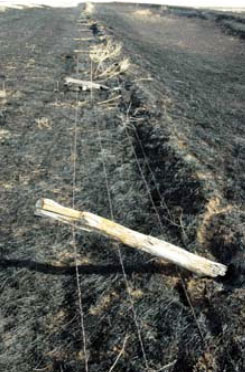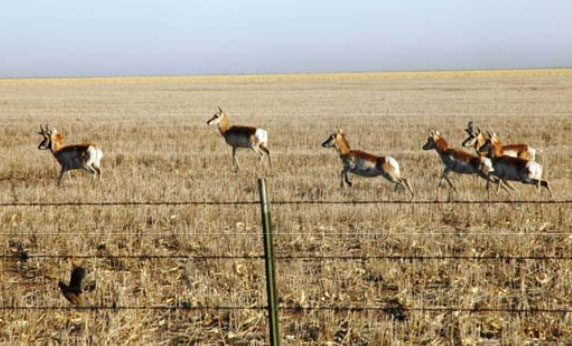All may appear lost, but with time and rain, pastures burned by recent wildfires will come back stronger if cattle are not restocked too early. The loss of standing vegetation affects not only the availability of feed for livestock, but also feed and cover, including nesting habitat for wildlife. The fire also removed litter and standing vegetation that protected the soil from water and wind erosion.
With few exceptions, the plants are still alive and will recover. Recovery may take a few months to a couple of years, depending on the climate and management of the areas. Management should focus on maintaining and improving plant vigor, rebuilding soil protection, and allowing for recovery of wildlife habitat and forage for livestock production.
The following is a checklist of considerations for post-fire management.
Rangeland Management
Don’t be anxious to begin grazing burned areas. Establish a management plan that will defer grazing until after the first growing season is completed (after first frost.) This will:
- Maintain and improve plant vigor and productivity;
- Reestablish litter and standing vegetation that reduce soil erosion;
- Develop cover and nesting habitat for birds during a critical period;
- Allow for production to benefit wildlife;
- Provide fawning cover for deer and pronghorns, reducing predation;
- Reduce the potential for toxic plant consumption by cattle.
Grazing too soon after the fire can slow these processes and delay the time required for full recovery. Defer any grazing until after mid-July if it is necessary to graze during the first growing season.
- With loss of cross-fencing, the ability to adequately manage forage resources with selective livestock grazing of certain pasture units is altered. This fact alone should further reduce any temptation to restock as the pastures undergo green-up and recovery.
- Base the number of cattle on the amount of forage available. Do not plan to return to customary stocking rates for two growing seasons. Recovery may be more rapid than this, but plan conservatively.
- If unburned pasture remains, use a grazing system that incorporates deferment of the burned area.
- Attempt to minimize impacts of overgrazing on unburned areas.
- Realize that broad-leaved plants (forbs or “weeds”) have a place. These plants provide soil cover, wildlife cover and food. With adequate rainfall, a flush of forbs will probably occur this spring; avoid the temptation to spray them.
- Hold off on brush control. Post-fire is a good time to treat prickly pear, but defer decisions on other brush species.
- Set up permanent photo-points to monitor recovery with landscape and vertical photos.
Cattle

- Evaluate all decisions to cull, or feed and maintain cattle, within the framework of the required rangeland recovery time. At least four months, ideally seven months, will be needed before the burned range can be partially restocked.
- Cull cattle based on age, productivity and cost of maintaining productivity.
- Maintain adequate nutrition to support milk production and reproduction.
- Spring calving cows are at the stage when nutrient requirements are greatest. Failure to meet these requirements can lead to excessive condition loss and delayed conception or failure to conceive.
- Poor quality roughage and hays will require supplemental protein and energy.
- Overstocking unburned areas can reduce cattle performance and increase supplemental feed requirements.
- Incorporate labor and equipment costs into all evaluations of feeding programs.
- Continue to evaluate cattle for latent effects of the fire — foot problems, respiratory problems.
- Evaluate calves for signs of inadequate milk consumption.
- Evaluate early weaning as an option to reduce feed requirements of cows.
- Cull cows with fire damage before they completely lose value.
Fencing and Facilities
Be aware of opportunities to change fencing layouts and types with the following in mind:
- A three-wire fence with bottom barbless wire at 18 inches above the ground allows free movement of antelope;
- Evaluate fence line layout for improved grazing management, livestock movement and wildlife benefits. Don’t assume an old fence ought to go back where it was. This will be a good opportunity to put them in optimal locations.
Wildlife

Grazing too soon in the spring can be detrimental to vegetation recovery and its value as a food source for wildlife.
- Keep water systems up and running, even if the cattle are de-stocked. Wildlife may depend on it as their sole source of water in some areas.
- Supplemental feeding for some deer may be necessary in large burned areas. Suggested feeds include alfalfa hay, pelleted protein/energy supplement, whole cottonseed, and corn (fed in relatively small amounts at first to avoid acidosis).
- Wildlife benefit from the protection that a good vegetative cover will provide if grazing is deferred long enough to allow for recovery of grasses, forbs and browse.
- The initial flush of forbs, grass and browse will be essential as a food source for wildlife. Protection from grazing through the first growing season, and then conservative usage thereafter, is recommended.
- Monitor quail abundance with whistle counts to document “holes” (presence or absence).
- Conduct deer/antelope surveys immediately before hunting season.
- Work in cooperation with hunters to ensure recovery of game populations.
Download or Print this Publication:
